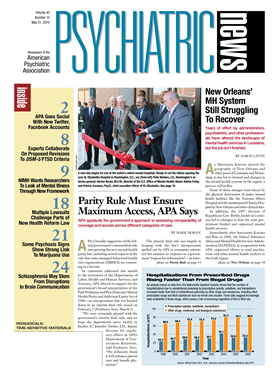APA is broadly supportive of the federal government's interim final rule interpreting the new mental health parity law, including several aspects of the rule that some managed behavioral health care organizations (MBHOs) are contesting in a lawsuit.
In comments addressed last month to the secretaries of the Departments of Labor, Health and Human Services, and Treasury, APA offered its support for the government's broad interpretation of the Paul Wellstone and Pete Domenici Mental Health Parity and Addiction Equity Act of 2008—an interpretation that was handed down in an interim final rule issued on February 2 (Psychiatric News, March 5).
“We were extremely pleased with the government's interim final rule, and we hope the departments move swiftly to finalize it,” Jennifer Tassler, J.D., deputy director for regulatory affairs in APA's Department of Government Relations, told Psychiatric News. “We definitely think it will enhance patient care and benefit physicians.”
The interim final rule was largely in keeping with the law's interpretation spelled out by APA in comments submitted last summer in response to a government “request for information”—an interpretation that views parity as not just about equality of coverage, but equality of access to care. Most notably, the rule requires that plans maintain a single deductible to cover mental health and medical/surgical services and that insurers cannot rely on certain cost-containment strategies used in the past if they are not also used in a comparable way to manage medical/surgical services.
Those two provisions in the government's rule are at the heart of a lawsuit brought by a group of MBHOs—including Magellan Health Services Inc., Beacon Health Strategies Inc., and Value Options (Psychiatric News, May 7). In the suit, the companies claim that the single deductible will raise costs and that the management strategies—such as medical-management standards, design of prescription-drug formularies, standards for provider admission to participate in a network, and fail-first policies or step-therapy protocols—are necessary to control costs and maintain parity of coverage.
These strategies are referred to in the interim final rule as “nonquantitative treatment limits” (NQTLs). They are distinct from quantitative treatment limitations, which can be measured numerically—such as annual and lifetime dollar limits and limits on office visits per year—and that are more clearly covered by parity provisions in the law. The government's rule extends the parity provisions to the NQTLs, saying that companies cannot apply them to mental health benefits if they are not also applied to medical/surgical services.
The regulations will be effective July 1, and a decision in the lawsuit is expected to be handed down before then. In late April, a motion submitted by the Parity Implementation Coalition—of which APA is a member along with some 15 other groups—to file an amicus brief in support of the government's rule was denied.
But in a nine-page letter signed by APA Medical Director James H. Scully Jr., M.D., APA outlined its support to the government for its interpretation while also requesting several points of clarification.
A third broad area addressed by the comments relates to the government's ruling on classification of benefits and scope of services. Those refer to the regulators' approach to assessing comparability of coverage and access across different categories of care. For example, the rule notes that copayments differ markedly depending on whether a service is rendered inpatient or outpatient and by an in-network provider or an out-of-network provider.
So how to apply parity across these different categories of service?
The government's answer was to create six categories—inpatient, in network; inpatient, out of network; outpatient, in network; outpatient, out of network; emergency care; and prescription drugs—and to require that treatment limitations be comparable within each category.
It's a system that APA says will work. “APA is extremely pleased that the departments have taken the approach to classify benefits into specific categories and apply the requirements from MHPAEA [Mental Health Parity and Addiction Equity Act] across those categories,” Scully wrote in the letter. “We believe that this is a logical system and will greatly simplify comparisons when determining if a plan or issuer has complied with the law.... We agree with the departments that the appropriate determining criteria for finding the predominant financial requirements and treatment limitations should be within a given classification of benefits.”
Moreover, Tassler told Psychiatric News that APA is requesting that the government go a step further and state that the six categories cover the “universe” of services—that insurers cannot exclude certain services because they do not apparently fit into any one and cannot create new categories by which they might segregate a service (and thereby apply different treatment limitations to it).
“The departments must clearly state that a plan may not exclude a particular service or benefit simply because it does not fall squarely into one of the six classifications proposed or because there is no analog on the medical/surgical side,” Scully continued. “There are frequently used mental health and substance use disorder services which do not fit neatly into one category or have a comparable medical/surgical service, but which nonetheless should be covered under MHPAEA. Additionally, APA would appreciate a clarification that insurers cannot create new benefit classifications for either mental health/substance use disorder treatment or medical/surgical care to skirt enforcement of the law, as we have grave concerns that plans will create such classifications and shift definitions of certain benefits to avoid providing mental health and substance use disorder benefits at parity.”
